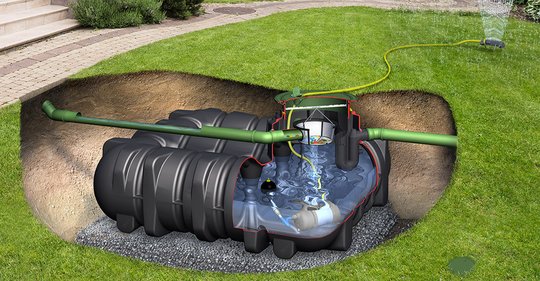Rainwater for the pool
"Here's the garden hose," says Anton, opening the water socket of the tank in his garden with one hand. It holds 10,000 liters. It is installed underground, aligned with the size of the house and garage roof and almost inconspicuously concealed under the green cover on the lawn. But it is indispensable for the Meier-Avas' garden - as well as for their refreshment. In fact, the family also uses its water to refill their pool when they run out of water.
"It's really easy," says Melanie and grabs the hose, takes it to the edge of the pool and puts it down. "One thing was important to us right from the start: when we build a pool, we pay meticulous attention to water consumption."
Sustainable refilling of the pool
The underground rainwater tank serves as a central reservoir for the sustainable refilling of the pool: as soon as the water level drops, the garden hose is once again connected to it. This means that drinking water is no longer required for refilling and the water quality in the pool is still 1A. "It is the same water that falls from the sky into the lakes and oceans." A sustainable approach - and at the same time an adaptation to what the consequences of climate change could threaten in the future: Because dry periods are becoming more frequent and drinking water consumption could be regulated by banning irrigation or simply by increasing the price of drinking water. Melanie is certain: "Thanks to our cistern, we won't be left high and dry. Thanks to the rainwater it collects during periods of rain, we can still swim for a while."

General rules for swimming pools
In addition to using rainwater for refilling, the pool rules for reduced water consumption also include the following basic measures that every pool owner should take into account:
- Even when (re)filling the pool with rainwater, you must pay attention to individual water treatment. This includes adjusting the pH value, treating for possible bacteria and contamination as well as appropriate descaling;
- Maintain the set water level and do not exceed it, otherwise too much water will flow into the wastewater (in the event of heavy rainfall, excess water must also be pumped out);
- Check and maintain the pool liner so that nothing leaks out;
- Use a good filter and reduce its washing and rinsing times (following the advice of their pool builder, the Meier-Ava family rinse their filter once a week)
- Use the right pump for the pool to circulate the water;
- Maintain the pool water with bromine (alternatively chlorine/active oxygen). The Meier-Ava family adds bromine to the water every two weeks during maintenance and anti-limescale tablets every week;
- Winterize the pool with suitable frost protection (not only saves water, but also helps the pool glass)


